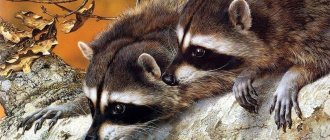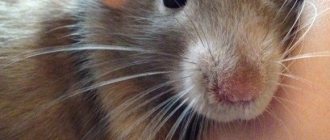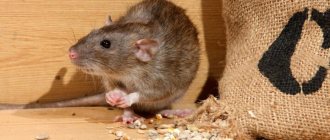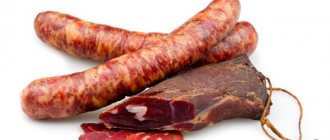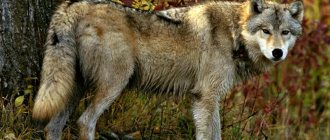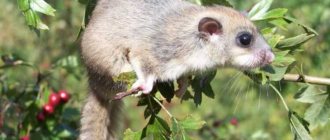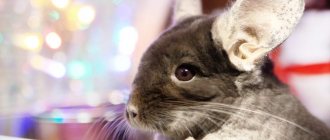09/08/2019 · 0 · All posts for September 2019
Raccoon - This is an adorable furry mammal common in Central and North America. Later, the animal gradually became accustomed to European countries. Despite the fact that the raccoon belongs to the order of predators, the animal gets along well next to humans.
Currently, the popularity of keeping a raccoon at home has increased dramatically. In the modern world, it is considered fashionable to have an exotic representative of wildlife in your home.
Unfortunately, breeders forget that a predatory animal can never become completely domestic. The largest species of the raccoon family is the striped raccoon, a representative of Eurasia. The individual is rightfully considered the largest among other breeds.
The body length of an adult animal is 60 centimeters and weighs from 5 to 9 kilograms. Raccoons are small in size - they resemble a cat or a small dog. The body is covered with thick dense gray fur.
The main distinguishing feature of the striped raccoon is its long striped tail. The forelimbs of the mammal are very developed, due to which the creature deftly climbs the treetops and holds various objects in its paws.
The animal got its name from its manic desire to rinse food before eating. However, at home, natural instinct takes over and the raccoon tries in every possible way to spend time near the water supply. With their habits, raccoons very often resemble small children.
The mammal constantly reaches out to communicate with humans, is capricious and tries in every possible way to cheer up others. In zoos, there are always a lot of spectators near the enclosures with raccoons.
The restless animal demonstrates its extraordinary abilities with particular enthusiasm. This phenomenon can be observed not only in the wild, but also at home.
A curious animal will explore the home, hide forgotten valuables of the owners, and also restore order at its own discretion. Owners are faced with a very important question: what do raccoons eat?
Everyone immediately remembers the line from the children's song, “The raccoon ate the blackberries with his mouth wide open.” Is it possible to give a raccoon berries and what delicacies does the animal love? It’s worth finding out in more detail.
Eating in the wild
By nature, raccoons are absolutely omnivorous. Life in the wild provides the opportunity for animals to eat:
- snakes;
- insects;
- mice;
- lizards;
- other rodents;
- frogs;
- crayfish;
- acorns;
- berries;
- bird eggs;
- turtles;
- fish;
- wild fruits;
- nuts.
In order to get food, the animal can go up to two kilometers from its home. In the wild, notes settle in abandoned holes or climb into hollow trees.
The peak activity of mammals occurs at night. Tenacious paws allow you to climb trees perfectly and hold various objects firmly in your paws.
Raccoons living in close proximity to human habitation eat everything they can find: trash, pizza, chips, soda water and other delicacies.
Special signs
Those who have seen a raccoon at least once, even in a picture, will easily recognize it the next time they meet it. This animal has an interesting and memorable appearance.
It is not difficult to describe a raccoon. The pointed face looks like it's wearing dark glasses, and a prominent striped tail completes the look. The fur on the back is darker than on other parts of the body. A black stripe runs from the tip of the nose to the small rounded ears. There is a white edge around the animal’s “mask,” and the long hairs on its cheeks look like whiskers.
The body of a raccoon is from 45 to 65 cm, stocky and dense. Average weight is approximately 6-7 kg. The fluffy tail consists of alternating black and gray rings, its length is about 25 cm. The animal’s height is small - 35 cm.
Feeding raccoons at home
In order to understand what to feed raccoons in captivity, you need to learn about the way these fascinating creatures feed in the wild. The diet should not only be balanced, but also healthy. Do not forget that raccoons are predatory animals.
Regardless of the type of animal - striper or albino, the raccoon eats everything. That is why the animal should definitely enjoy the following types of protein foods as homemade meals:
- meat;
- milk;
- seafood;
- bird;
- eggs.
Gargles simply adore plant food. It is very common to see a raccoon eating grapes, cherries, olives or bananas. In addition to the listed delicacies, gargles will gladly accept for lunch:
- vegetables: melons, zucchini, pumpkin.
- nuts: hazelnuts, pistachios, walnuts, almonds.
- berries: strawberries, grapes, mulberries, gooseberries.
- cereals: buckwheat, rice, corn and rolled oats.
During the cold season, raccoons very often need dried fruits. Often, owners give their pets dry formula for other pets (dogs or cats).
Types, photos and names
As we wrote above, there are 4 types of raccoons in nature, and below we will describe them in more detail:
Raccoon gargle
This raccoon got its unusual name due to its habit of rinsing caught prey in water. Thus, the clean raccoon cleans it of sand. It is also the most common among raccoons, found throughout North and Central America, and more recently in Europe. Everything we wrote above concerns primarily raccoons.
Racoon crayfish (aguara)
A distinctive feature of this raccoon is a characteristic pattern around the eyes, somewhat reminiscent of a bandit mask. This raccoon has shorter fur and a more streamlined body. It got its name from its gastronomic love for crayfish. Lives in the jungles of Central and South America.
Cozumel raccoon
This species of raccoon is very rare, as it lives in a limited area, namely on the small island of Cozumel in the Caribbean Sea. It also differs from its other relatives in its brownish-grayish fur and the presence of a yellow tint on the tail.
Guadalupe raccoon
This species of raccoon is currently critically endangered and is listed as
Red Book. It lives in the humid areas of Guadeloupe, preferring to settle in marshy areas, as well as near reservoirs, rivers and lakes. Its appearance is similar to a striped raccoon.
Principles of nutrition
With the onset of dusk in the wild, striped raccoons go hunting. At home, it is enough to follow the correct diet:
- before bed;
- in the evening – 7 o’clock;
- at night - at 11 o'clock.
On the Internet, you can often see videos of raccoons eating cake, pancakes, plums or olives. The animal will always ask its owner for something tasty.
Improper feeding can lead to excess weight gain and intestinal problems. Domestic raccoons generally do not hibernate.
Seasonal feeding
The diet changes noticeably during periods of hibernation not only among wild, but also among domestic raccoons:
- with the onset of autumn cold weather, the animals noticeably gain weight and constantly want to eat;
- Winter cold does not become an obstacle in the life of domestic gargles, but the activity of the animals is noticeably reduced. Thus, the owner reduces the diet by half;
- the warm season literally awakens pets and promotes metabolic activation;
- Summer is a great time to indulge in a wide variety of delicacies.
Feeding the young
Depending on age, the diet for young animals follows some recommendations:
- Puppies up to 1.5 months. Babies require special attention. They need to eat not only during the day, but also at night every three to four hours. After each meal, the owner should monitor the puppy's health and give him a tummy massage. Breeders feed one-month-old raccoon puppies with cat milk replacer using a dropper or baby bottle;
- Babies from 1.5 to 2.5–3 months. The younger generation is fed milk formula with the addition of grated cottage cheese, eggs and banana. At first, babies are given small portions;
- From 3 months. At the age of three months, puppies feed independently from a bowl.
Habitats
Where do raccoons live? Raccoons are native to North and South America and can be found in forests from Canada to Argentina. With the discovery of America by Europeans, raccoons came to Eurasia and one of their species, the striped raccoon, was able to take root quite well in our latitudes. In particular, populations of the striped raccoon have been created in many European countries and also in the Caucasus.
As for our country, Ukraine, in the hometown of the author of the article - Lviv, there is a whole raccoon farm - “
Raccoon House”, that is, you can come to visit the raccoons, play with them; such an event will definitely be unforgettable for children. To learn more about the “Raccoon House” in Lviv, follow the link.
Raccoon's house.
Diet of adults
Raccoons become adults at one year of age. In order to identify your pet’s favorite dish, you need to carefully observe it. At home, raccoons love to play pranks and act up in order to be given something tasty.
Together with its owner, the raccoon can eat apples, cookies and pizza. As soon as the raccoon’s health begins to noticeably deteriorate, you should immediately contact a veterinarian. Under no circumstances should you give your raccoon fatty foods.
Video
And finally, an interesting documentary about raccoons.
Author: Pavel Chaika, editor-in-chief of Poznavaika magazine
When writing the article, I tried to make it as interesting, useful and high-quality as possible. I would be grateful for any feedback and constructive criticism in the form of comments on the article. You can also write your wish/question/suggestion to my email [email protected] or Facebook, with respect, the author.
Author page
This article is available in English -
Raccoon.
Recommendations from experts
Very often, new raccoon owners get confused and do not understand what raccoons eat on a daily basis. Professional breeders advise making a special lunch for their pets that raccoons will definitely like:
- Place one kilogram of minced chicken in a large saucepan with water and bring to a boil;
- add your choice of 1 kilogram of cereal, rice or buckwheat;
- bring to a boil and simmer over low heat for about ten minutes;
- then leave for half an hour;
- While the porridge is cooling, fruits and vegetables need to be washed and grated;
- mix fruits and porridge, season with butter;
- several times a week cottage cheese and a couple of chicken eggs are mixed into the porridge;
- Food can be stored for no more than two days in the refrigerator.
Interesting Facts
Natural enemies
In their natural habitat, raccoons can become victims of wolves, jackals, lynxes, foxes, and large birds of prey. In some regions of their habitat, the animals are attacked by snakes and alligators. Fleeing from pursuit, the animal pretends to be dead, and as soon as the enemy hesitates or is distracted, it immediately runs away and hides.
The cause of death of raccoons is often infectious diseases. Research has shown that animals living in areas outside their historical range are more likely to get sick. Raccoons, like all predators, are susceptible to helminthiasis: more than 50 species of helminths can live in their bodies. Animals are also carriers of diseases dangerous to humans: tuberculosis, rabies, trichinosis, toxocariasis.
A LION
How to make friends with your pet and stop him from biting?
You can tame a raccoon only from a young age
If you want to tame a raccoon, or at least get as close to this result as possible, try to take it when it is still a baby, until the animal reaches 4 months of age. The younger the puppy, the easier it is to raise him. However, don't be fooled into thinking that this will happen quickly.
Raccoons are not only smart, but also capricious. Therefore, when training, you need to convey to your pet that the only owner of the situation here is you. Also keep in mind that females always claim primacy more than males.
Important! When raising raccoons, keep in mind that they will never accept physical punishment. The animal regards this as an attack and attacks in response.
When raising a striper, you need to rely on its behavioral factors. If the animal behaves obediently, respond with affection and reward with a treat. Make this strategy as clear as possible, as other methods will be less effective.
Some owners use a special clicker, which can be purchased at a pet store. Using this simple device, you can develop a cause-and-effect relationship between the raccoon’s action and punishment through a sound signal. To suppress an unwanted action, the command “No!” is used.
Important! Raccoons perceive high-frequency sounds aggressively. Try to communicate with the animal in a low voice.
By the way, stripers love to bite. In this way they communicate with the “interlocutor”. It is almost impossible to wean your pet from this habit. If your animal bites too aggressively and does not understand commands, then you can only wear gloves when playing with it.
Sometimes it is simply impossible to pacify an angry raccoon. In this case, you can use a plastic bottle. Just knock the empty container near your pet and immediately say the command “No” in a low voice. The sound from the impact is voluminous and loud, which distracts the rinser’s attention. Over time, words alone will be enough for educational moments.
Basic principles of feeding
Raccoons are beautiful, smart, inquisitive, and most importantly, active and very cunning. These are nocturnal animals, so be prepared in advance for the fact that you may not be allowed to sleep.
Based on the peculiarities of the regime and the recommendations of veterinarians, the raccoon needs to be given food three times a day, the feeding schedule is as follows: in the morning (or when the animal goes to bed), in the evening at six to seven o’clock and the last feeding is at ten to eleven o’clock, maximum - midnight.
Try not to overfeed the animal, although they are quite active by nature, a home lifestyle can contribute to excess weight gain and affect health.
In cold winters, raccoons can hibernate, this also applies to pets; of course, there is no need to be afraid that the animal will sleep for several months, but a raccoon can take a nap for a week or two during frosty periods. And your minke will wake up only when he gets hungry.
The legend of "hands"
The five-toed paws of a raccoon are interestingly designed. They are equipped with sharp claws that allow the predator to deftly climb, even upside down. Their mobility is so high that the animal uses its paws like a human. What a raccoon eats, it eats while sitting on its hind legs, and with its “hands” it puts pieces of food into its mouth.
The Indians claim that the raccoon was once a person, so they do not eat its meat. According to legend, the swindler who fooled everyone around his finger went unpunished for a long time. The main Spirit did not like this, and he turned the villain into a raccoon. For good behavior, the animal was returned to “human” hands.
Housing
- Cell.
Even if you are counting on free keeping, which involves the presence of a raccoon in all rooms of the apartment, buy a cage for your pet. The aviary will be especially useful in those moments when the owners leave the apartment or cannot sleep peacefully due to the fact that the gargle wanders from corner to corner. - Little house.
If desired, you can equip the cage cavity with a kind of house, the main thing is that it is not made of polystyrene foam, fabric or foam rubber. Give preference to plastic beds that are designed for small cats and dogs. It is desirable that the house be covered in the shape of a mink. Raccoons love the dark, so they often hide while they sleep. Place bowls for food and water near the house. - Rinse basin.
The main aspect that distinguishes the raccoon from other animals is that it loves to rinse. Take care of a basin with clean running water, which will be located next to the house. You can put a small piece of fabric in the container. You should not deprive the animal of its natural needs; rinsing is in the blood of raccoons. - Tray.
Equip the far corner of the cage with a tray. Teach your pet to relieve himself in a specially designated place, and not where he pleases. Such a move will help avoid “mines” when you let your pet run around the apartment. - Toys.
Raccoons are very playful and cheerful creatures. For a full-fledged existence, they need to have a large number of toys. Give preference to products made of fabric, but without padding polyester filling. If a raccoon swallows it, there is a risk of intestinal blockage and, as a result, death. Pet stores sell rattle toys for parrots and cats. Do not buy products made from painted rubber and silicone. Since raccoons are very smart and curious creatures, purchase a cube for the animal that consists of several sections.
Lifestyle
The animal has to obtain food in order to store fat reserves for hibernation. It comes closer to winter and lasts up to five months. In warmer climates, raccoons do not fall asleep, their activity simply decreases. The mating season begins in the spring, and babies appear two months later. Usually there are 3-4 blind cubs in a litter. Females feed them with milk, and by 6-7 months the babies can already hunt. At the age of one year, females begin puberty; males begin mating much later.
Content Features
- Unlike cats, dogs and even ferrets, raccoons require 5-7 times more attention. You need to constantly play with them; you will have to monitor the animal at least 18 hours a day.
- It is important to understand that domesticating raccoons is a long and grueling process. Even if you get another small animal, it is not a fact that it will completely get used to its owners. It will take a long time until your new guest begins to trust you. Animals bite painfully, so the process of adaptation will not take place without holes in the fingers of the owners.
- Raccoons are nocturnal pets; they will not change their usual routine at the whim of their owner. Unlike ferrets, which adapt to humans, stripers are more temperamental. This suggests that as soon as you fall asleep, the raccoon will begin to lead an active lifestyle. He will jump, gallop, and climb into hard-to-reach places. In this case, the actions are usually accompanied by a “hooting” sound, similar to a bird’s drill. It is at night that the raccoon makes provisions for a rainy day, so it is especially important to put food and other things in hard-to-reach places.
- For the reason stated earlier (raccoons bite painfully), it is not recommended to keep pets in an apartment or house where small children live. The baby can scare the animal, as a result of which the latter will begin to show aggression. As a result, you will get a crying child and a scared raccoon.
- As for the mischief of garglers, they prefer to scratch wallpaper, damage furniture upholstery, linoleum, curtains, etc. For this reason, raccoons are kept in a house or apartment that is not of particular value in terms of repairs. You can also give the animal a separate room with bare walls by installing its cage and house in the room.
Important!
Breeders do not recommend getting a raccoon to people who have not encountered keeping animals before. A pet requires careful monitoring from the outside, you need to be present in its life, the animal needs to be trained. However, if you previously owned a dog, ferret or cat, you can decide on a similar adventure. At first, the rinse's behavior may be shocking, but over time you will get used to it.
Predatory habits
Everything a raccoon eats is obtained at night. Nature has endowed them with acute vision, smell and hearing. In addition, the little hunter is helped by a special mechanism - vibrissae. These are ultra-sensitive hairs located on the head, paws and belly of the animal. They detect the movement of air masses that are reflected from various objects. Each antennae has many nerve endings. To obtain food, the animal uses only the nearby territory with a radius of about one and a half kilometers.
Raccoon paws are the main tool in hunting. They allow the animal to quickly hide from larger predators, deftly climb a tall tree, or hang on one “arm.” Any acrobat will envy his refined movements. If the striper does not have time to hide from the threat, it can feign death. Raccoons live for about five years.



